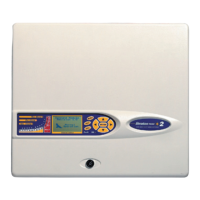Page 19
Stratos HSSD-2 • INSTALLER’S HANDBOOK • Iss. 12
3.4.26 Battery check enable (Yes/No - Address 000-127)
Setup menu > Power checks
If no battery back-up is required, this function should be set to No to avoid
Battery fault being displayed on the front panel. If a back-up battery is used, it is
recommended that the battery check be enabled. When this is done the user will be
prompted for an input terminal to use. The battery fault will be displayed when this
contact is open. The default setting is battery fault enabled on “I/P 1”. Section 5.3.1
“Detector terminal block connections” and Section 5.3.2 “Command Module terminal
block connections” show the input terminal connections for the Standard Detector and
Command Module respectively.
3.4.27 Mains check enable (Yes/No - Address 000-127)
Setup menu > Power checks
The Stratos-HSSD 2 detector and Command Module are capable of signalling power
supply faults from the power supply where this is equipped with a fault relay (the
power supply fitted by default has this feature). The mains check is disabled by default.
If the user sets this function to Yes , the user will be prompted with an unassigned input
terminal to use (this will normally be “I/P 2” if battery check is already enabled on “I/P
1” - see section 3.4.26, ‘Battery check enable’).
The mains fault will be displayed when this contact is open.
3.4.28 Aspirator speed (Numeric - Address 001-127)
Setup menu > Air flow
The value entered sets the aspirator in the detector to one of a range of predetermined
speeds. The lower the number entered the lower the airflow rate and the lower the
power consumption.
3.4.29 Flow setup (Yes/No - Address 001-127)
Setup menu > Air flow
Setting this function to Yes puts the detector into automatic flow limit setup mode.
This takes a few minutes to set the flow fault thresholds based on the current flow rates.
3.4.30 Airflow monitoring (Display / Numeric - Address 001-127)
Setup menu > Air flow
There are separate Sensor pipe , Flow low , Flow high and Flow pipe
parameters for each pipe 1 to 4 on the detector. For example, Flow pipe 1 indicates
the current airflow rate for pipe 1.
Sensor pipe 1 to Sensor pipe 4 are used to enable or disable flow sensing on
the specified pipe inlet of the detector. If any pipe inlets are unused, set the relevant
flow sensor function for the pipe inlet to No to avoid unwanted flow faults.
Flow low is the level below which airflow needs to be reduced to trigger a fault
reading (which may indicate a blocked pipe) and Flow high is the level above which
airflow needs to increase to trigger a fault indication (which may indicate a loose or
damaged inlet pipe).
Flow low and Flow high parameters are automatically set up on initial power-up or
when Flow setup is selected (see section 3.4.29).
The airflow rates Flow pipe 1 to Flow pipe 4 are for display purposes only and
cannot be changed.

